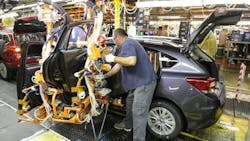Subaru's Expanded Indiana Plant Sees First Impreza Roll Off the Line
Subaru marked a milestone Tuesday in the expansion of its manufacturing operations in Indiana, as the first US-made Impreza rolled off the assembly line.
Production of the Impreza, which was previously produced solely in Japan, was integral to the expansion of the automaker’s plant facilities in Lafayette, Ind.
Subaru of Indiana Automotive, Inc. (SIA), parent company Fuji Heavy Industries’ (FHI) U.S. manufacturing subsidiary, has invested $1.3 billion in the Lafayette plant in the past four years and hired an additional 1,400 workers for the expansion.
According to a Subaru press release, FHI decided to move production of the Impreza to the U.S. because of increasing American demand for Subaru vehicles and the plant’s “high level of operational and production quality.”
The Lafayette plant also produces Legacy and Outback models.
Subaru vehicle sales in the U.S. have increased for eight consecutive years. Sixty percent of Subaru buyers are now in the U.S.
With the addition of the Impreza, the Indiana facility will produce more than 380,000 vehicles annually. The plant opened in September 1989, and has since produced close to 5 million vehicles.
The expansion included building a new paint shop and enlarging the engine assembly, trim and final assembly, and stamping sections.
FHI CEO Yasuyuki Yoshinaga told the Wall Street Journal the company planned to ramp up production slowly—to 436,000 cars by March 2019, double that of March 2016—to increase a tight inventory and meet demand. He said he preferred to keep a “slight shortage” of cars on the lot than risk excess.
About the Author

Laura Putre
Senior Editor, IndustryWeek
As senior editor, Laura Putre works with IndustryWeek's editorial contributors and reports on leadership and the automotive industry as they relate to manufacturing. She joined IndustryWeek in 2015 as a staff writer covering workforce issues.
Prior to IndustryWeek, Laura reported on the healthcare industry and covered local news. She was the editor of the Chicago Journal and a staff writer for Cleveland Scene. Her national bylines include The Guardian, Slate, Pacific-Standard and The Root.
Laura was a National Press Foundation fellow in 2022.
Got a story idea? Reach out to Laura at [email protected]
